Tooth and Gum Trouble
Bacteria in your mouth form a sticky film (plaque) on teeth and gums. If not removed, this film hardens into a crust (tartar, also called calculus). A bulidup of plaque and tartar can cause an infection called periodontal disease. Periodontal disease can lead to pain, gum damage, bone loss, and even tooth loss. Scaling and root planning is a special type of cleaning done by a dental professional (general dentist, dental hygienist, or periodontist). This cleaning removes plaque and tartar. It helps restore the health of your teeth and gums.
Healthy Gums
In a healthy mouth, gums are firm. Firm, healthy gums protect teeth and bone.

Infected Gums
Infected gums bleed, swell and recede (pull away) from teeth. Teeth may loosen and become sensitive. As the infection worsens, bone may be lost and teeth may fall out.
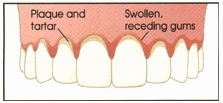
Your Evaluation
Your dentist determines how advanced your periodontal disease is nad how much damage has been done. Your gums are looked at for bleeding and swelling. Your teeth are checked for looseness and sensitivity. Full mouth x-rays help show if there is bone loss around your teeth.
Periodontal Probing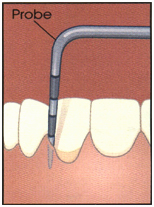
Periodontal probing helps measure how advanced your disease is. During probing, a tool(probe) measures the space (called the pocket) between each tooth and the surrounding gum. The deeper the pocket, the more severe the problem.
The Procedure
Scaling and root planning removes plaque and tartar from below your gum line. This controls the growth of harmful bacteria. It also helps gums reattach firmly to the teeth. Because this procedure goes deeper than a regular cleaning, your mouth may be numbed. The cleaning may take two to four or more visits to complete.
Scaling
Scaling is a type of cleaning. It removes plaque and tartar from around and below the gum line.
Root Planing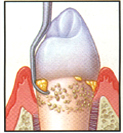
Root planing involves scraping and smoothing the root surfaces of your teeth. Gum tissue can more firmly reattach to roots that are clean and smooth.
After Your Procedure
Your mouth may feel sore and tender after treatment. Keep brushing and flossing your teeth after each meal. Rinse with warm salt water every few hours. Pain medication may be suggested if you need it.
Brush and Floss Right !
Brushing and flossing help keep your teeth and gums healthy. They stop plaque and tartar from building up on your teeth. Brush after every meal. Floss at least once a day. And be sure to brush and floss right. The tips below tell you how:
Brushing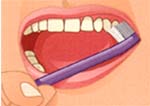
- Use a soft toothbrush and fluoride toothpaste.
- Hold the brush at a 450 angle to your gum line. This lets the bristles reach under the gums. Gently brush the outer and inner surfaces of your teeth.
- Use the top bristles to clean the inside of the upper and lower front teeth
- Scrub the chewing surfaces.
- Brush your tongue to clear away food and bacteria. Then rinse well.
Flossing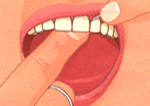
- Ask your dentist to recommend the type of dental floss that’s best for you.
- Wrap 18 inches of floss around your middle fingers. Hold it tight between your thumb and index finger.
- Ease the floss between your teeth. Rub up and down against the sides of each tooth.
- Be sure to floss below your gum line where plaque tends to collect.
Remember ………
Periodontal disease can be an ongoing problem. Keep your gums and teeth healthy: brush, floss, and visit your dentist for regular exams and cleanings. Eat a healthy diet. If you smoke or chew tobacco, quit. And call your dentist if you notice any tooth or gum problems.

